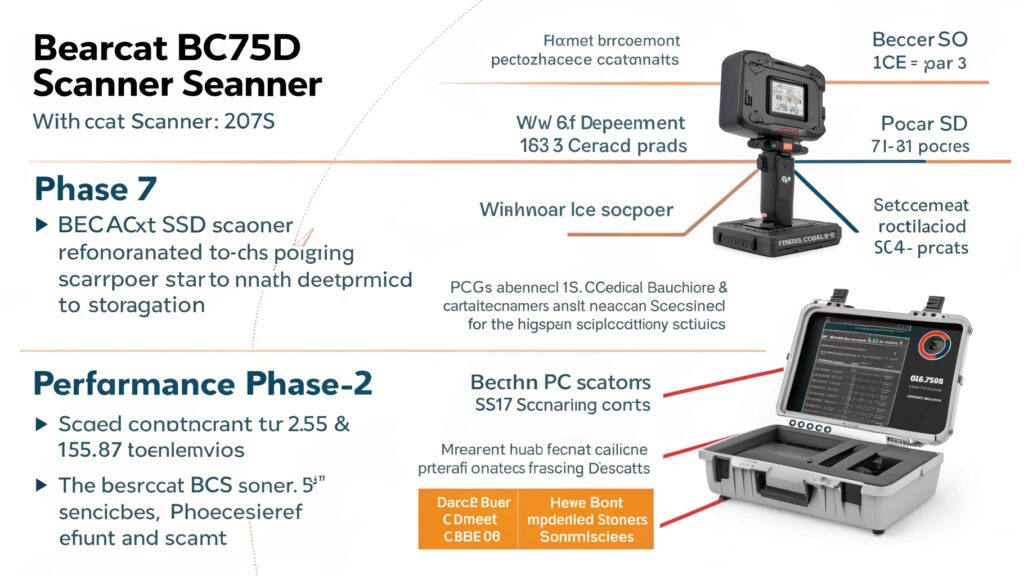The Bearcat BCS785D is a digital trunk-tracking scanner that has earned a loyal following among radio hobbyists for its solid build, clear audio, and dependable analog and digital monitoring capabilities. Designed during a time when Phase 1 systems dominated public safety communications, the BCS785D was considered advanced for its era. Today, as Phase 2 P25 digital systems have become more widespread, many owners and potential buyers are asking whether this model can keep up with modern scanning needs.
What Does Phase 1 and Phase 2 Mean in Scanners?
In the scanner world, P25 Phase 1 refers to the first-generation digital radio standard used by many police, fire, and emergency services. It operates using FDMA technology, allowing one voice channel per frequency. P25 Phase 2 is the newer standard that uses TDMA technology, effectively doubling channel capacity and improving spectrum efficiency. The difference is critical because a scanner designed for Phase 1 will not necessarily decode Phase 2 transmissions without the right hardware and software capabilities.
Technical Specifications of the Bearcat BCS785D
The Bearcat BCS785D covers a wide range of frequencies, including VHF, UHF, and 800 MHz bands, and supports both analog and APCO P25 digital reception when equipped with the optional BCi25D digital card. It uses trunk-tracking technology for Motorola, EDACS, and LTR systems, with modulation types such as FM, NFM, and APCO P25 Phase 1. Its performance is dependent on both hardware configuration and the type of system being monitored.
Is the Bearcat BCS785D Phase 1 or Phase 2?
Out of the box, the Bearcat BCS785D is a Phase 1-capable scanner when paired with the BCi25D digital card. It cannot decode native Phase 2 TDMA signals. While it can follow a Phase 2 system’s control channel, it will only receive Phase 1 talkgroups on that system. This limitation is due to the scanner’s hardware design, which predates widespread Phase 2 adoption.
Upgrading the Bearcat BCS785D for Better Compatibility
Owners can enhance Phase 1 performance by installing the BCi25D digital card and ensuring the latest firmware is loaded. However, no firmware or software update can make the BCS785D fully Phase 2 compatible because Phase 2 decoding requires TDMA-capable hardware. External solutions, such as pairing the scanner with a PC-based SDR setup running Phase 2 decoding software, are possible but require additional equipment and technical know-how.
Performance in Phase 1 vs Phase 2 Systems
On Phase 1 systems, the Bearcat BCS785D performs reliably, offering clear digital audio and strong reception when properly configured. On Phase 2 systems, it is limited to monitoring any talkgroups that remain in Phase 1 mode, which is increasingly rare as agencies migrate fully to Phase 2. For hobbyists in areas still running Phase 1 systems, the BCS785D remains useful; for Phase 2-dominant regions, its utility is significantly reduced.
Pros and Cons of the Bearcat BCS785D
Pros of the BCS785D include solid Phase 1 performance, sturdy construction, and flexibility in analog and early digital scanning. Cons include a lack of native Phase 2 support, reliance on an optional digital card, and a dated user interface compared to modern scanners. For collectors or those in Phase 1 areas, it’s a worthwhile unit; for others, a newer model may be better.
Alternatives to the Bearcat BCS785D for Phase 2 Listening
For those who require Phase 2 monitoring, alternatives such as the Uniden BCD996P2, BCD436HP, or Whistler TRX series are better suited. These models natively support P25 Phase 2 TDMA, have improved dynamic memory management, and offer firmware upgrade paths for future digital modes. While more expensive, they ensure compatibility with evolving public safety communications.
User Experiences and Reviews
Owners often praise the BCS785D for its durability and strong audio quality, particularly when using the BCi25D card for Phase 1 reception. However, reviews frequently note frustration with its inability to handle Phase 2 traffic. Online scanner forums and hobbyist groups often recommend it for rural or smaller markets where Phase 1 still dominates, but not for urban areas that have fully upgraded to Phase 2.
Buying Guide for the Bearcat BCS785D
If considering the purchase of a Bearcat BCS785D today, buyers should verify whether their local systems are still Phase 1 compatible. The scanner is no longer in production, so units are typically found second-hand through online marketplaces or radio hobbyist communities. Pricing varies based on condition and whether the BCi25D digital card is included, as the card alone is increasingly rare and valuable.
Conclusion: Is the Bearcat BCS785D Still Worth It?
The Bearcat BCS785D remains a solid choice for those monitoring Phase 1 systems, but its lack of Phase 2 capability limits its future viability. In areas where Phase 1 is still active, it offers reliable performance and strong reception. For those seeking long-term compatibility, investing in a newer Phase 2-capable scanner may be the more practical option.
FAQs About Bearcat BCS785D
Is it fully compatible with Phase 2?
No, it can only receive Phase 1 talkgroups on Phase 2 systems.
Does it need a digital card for Phase 1?
Yes, the BCi25D digital card is required for digital Phase 1 reception.
Can firmware updates add Phase 2?
No, Phase 2 support requires specific hardware not present in the BCS785D.
Is it good for analog scanning?
Yes, it performs very well on analog systems and trunked analog networks.
How much does it cost now?
Prices vary from $100 to $300 depending on condition and whether the digital card is included.

